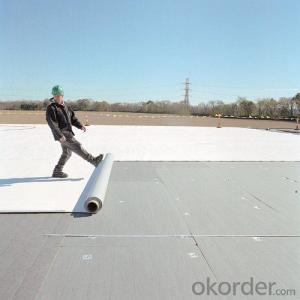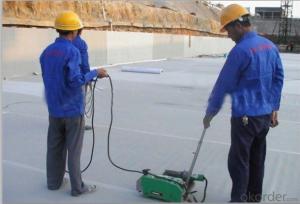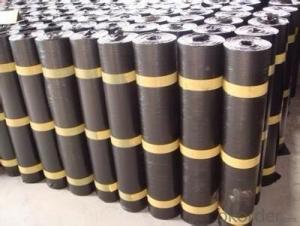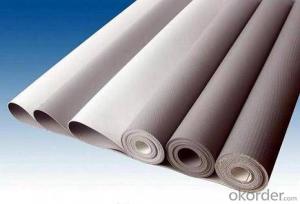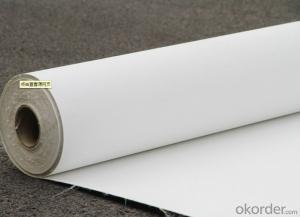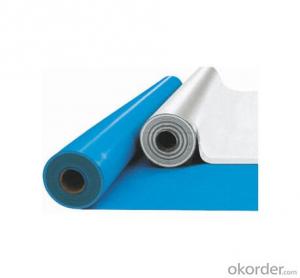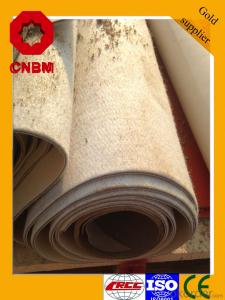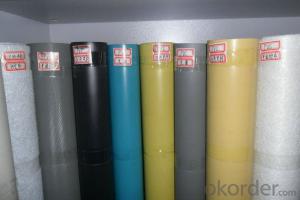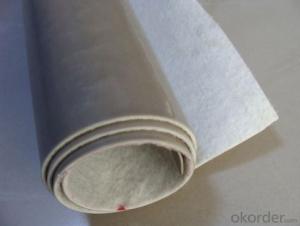PVC Waterproofing Membrane of Best Quality
- Loading Port:
- China main port
- Payment Terms:
- TT OR LC
- Min Order Qty:
- 5000 m²
- Supply Capability:
- 100000 m²/month
OKorder Service Pledge
OKorder Financial Service
You Might Also Like
PVC Waterproofing Membrane is widely used to waterproof field as a new kind of membrane.
1.Technical data of PVC Membrane
No. | Item | Index | ||||||
H | L | P | G | GL | ||||
1 | resin thickness over the fabric mm,≥ | — | 0.4 | |||||
2 | tensile strength | max tension (N/CM),≥ | — | 120 | 250 | 120 | ||
tensile strength/Mpa,≥ | 10 | — | — | 10 | — | |||
elongation at max tension/%,≥ | — | — | 15 | — | — | |||
break elongation/%,≥ | 200 | 150 | — | 200 | 100 | |||
3 | thermal size change/%,≤ | 2 | 1 | 0.5 | 0.1 | 0.1 | ||
4 | low temperature flexibility/℃ | —25 no crack | ||||||
5 | impermeability | 0.3MPa,2h impermeable | ||||||
6 | anti-impact | 0.5kg.impermeable | ||||||
7 | static load | 20kg impermeable | ||||||
8 | cut strength/(N/mm),≥ | |||||||
joint peeling strength/(N/mm),≥ | 4 | 3 | ||||||
9 | vertical tearing strength/(N/mm),≥ | 50 | — | — | 50 | — | ||
10 | trapezoid tearing strength/(N/mm),≥ | 150 | 250 | 220 | ||||
11 | water absorption(70℃,160h)% | after saturation≤ | 4 | |||||
after dry≤ | —0.4 | |||||||
12 | heating aging | hour/h | 672 | |||||
appearance | no bubble,crack,seperation | |||||||
tensile strength retention/% | ≥85 | |||||||
elongation retention/% | ≥80 | |||||||
low temperature flexibility retention/℃ | —20 no crack | |||||||
13 | anti chemical property | appearance | no bubble,crack,seperation | |||||
tensile strength retention/% | ≥85 | |||||||
elongation retention/% | ≥80 | |||||||
low temperature flexibility retention/℃ | —20 no crack | |||||||
14 | artificial | hour/h | 1500 | |||||
appearance | no bubble,crack,seperation | |||||||
tensile strength retention/% | ≥85 | |||||||
elongation retention/% | ≥80 | |||||||
low temperature flexibility retention/℃ | —20 no crack | |||||||
2.Characteristic of PVC Membrane
1.Strong tensile strength, high elongation, can fit big deformation of substrates.
2.Excellent anti-extreme weather property, can adapt to various environment temperature difference.
3.Suitable for exposed projects with long lifetime and good anti-aging property.
4.Can be welded firmly and reliably.
5.Outstanding root penetration resistance, best choice for planted roofs.
6.Simple and fast construction without pollution.
7.Great plasticity and fast treatment with corners and details.
3.Applicable scope of PVC Membrane
PVC sheet forms an effective barrier to liquid water or water vapor in the roof construction for industrial and civil engineering, underground engineering such as subway& tunnel, water conservancy such as water pools & ditch, shelter, grain depot, land filling, dyke, sewage treatment and basement.
4. FAQ of PVC Waterproofing Membrane
a.Can we get some samples before place order?
Answer: We can send the free samples to you by freight collect.
b.How many years can your PVC membrane guarantee?
Answer: We will guarantee the quality for 5 years at least.
c.Which countries you ever export the product?
Answer: We export the PVC membrane to South Africa, Middle east and even European countries.
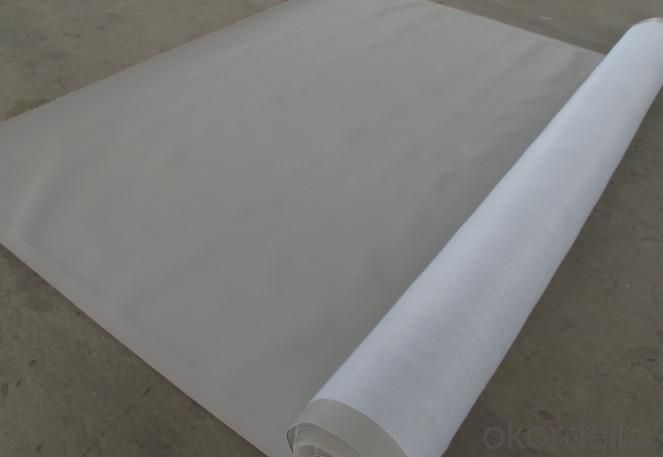
- Q: Can a waterproofing membrane be used in areas with extreme temperatures?
- Indeed, in areas with extreme temperatures, it is possible to utilize a waterproofing membrane. Numerous waterproofing membranes are specifically crafted to endure a vast spectrum of temperatures, ranging from scorching hot to freezing cold. These membranes are manufactured using materials that exhibit resistance against cracking, melting, or brittleness when exposed to extreme temperatures. Moreover, certain waterproofing membranes are specially engineered for deployment in regions with extreme temperatures, such as arctic or desert environments. To guarantee efficacy and durability, it is crucial to select a waterproofing membrane that aligns with the specific temperature range of the intended area of use.
- Q: Can a waterproofing membrane be applied in cold weather?
- Yes, a waterproofing membrane can be applied in cold weather. However, there are certain considerations that need to be taken into account. It is important to use a membrane that is specifically designed for cold weather applications as some membranes may not perform optimally in low temperatures. Cold weather can affect the curing process of the membrane, so it is crucial to follow the manufacturer's guidelines regarding temperature limitations and application techniques. The surface to be waterproofed should also be clean and dry before applying the membrane, as moisture or ice can interfere with adhesion. In cold weather, it may take longer for the membrane to fully cure and achieve its maximum performance. Therefore, it is advisable to allow sufficient time for the membrane to dry and cure before exposing it to water or other stressors. It is also important to note that extreme cold temperatures can negatively impact the installation process and the overall effectiveness of the waterproofing system. Therefore, it is recommended to consult with a professional waterproofing contractor who has experience working in cold weather conditions to ensure the best results.
- Q: Can a waterproofing membrane be painted or covered with a protective layer?
- Indeed, it is possible to paint or apply a protective layer to a waterproofing membrane. Nonetheless, it is crucial to select the appropriate paint or protective layer that is explicitly formulated for use with waterproofing membranes. This guarantees the preservation of the membrane's integrity and its ability to effectively safeguard against water damage. Additionally, adhering to the manufacturer's instructions and recommendations during the application process is of utmost importance. This may involve adequate surface preparation, utilization of suitable application techniques, and adherence to maintenance instructions. By adhering to these guidelines, the waterproofing membrane can be painted or covered with a protective layer while maintaining its efficacy.
- Q: Can a waterproofing membrane be used for a podium deck?
- Yes, a waterproofing membrane can be used for a podium deck. A podium deck is an elevated platform or structure that is commonly found in commercial buildings or multi-story residential complexes. Due to its elevated position, a podium deck is exposed to various weather elements, including rain and moisture. Therefore, it is essential to have a reliable waterproofing system in place to protect the underlying structure from water damage. A waterproofing membrane is a popular choice for podium decks as it offers an effective barrier against water penetration. This membrane is typically applied underneath the deck's surface and acts as a protective layer that prevents water from seeping into the underlying structure. It is designed to be durable, flexible, and resistant to the effects of weathering, ensuring long-term protection for the deck. Furthermore, a waterproofing membrane can also provide additional benefits for a podium deck. It can act as a vapor barrier, preventing the buildup of moisture within the structure, which can lead to mold growth and deterioration of materials. Additionally, some waterproofing membranes offer enhanced UV resistance, which helps in prolonging the lifespan of the deck and maintaining its aesthetic appeal. When choosing a waterproofing membrane for a podium deck, it is crucial to consider factors such as the deck's design, the anticipated level of foot traffic, and the local climate conditions. Different types of membranes, such as sheet membranes, liquid membranes, or spray-applied membranes, may be suitable depending on the specific requirements of the project. In summary, a waterproofing membrane can indeed be used for a podium deck. It provides a reliable and effective solution for protecting the deck and the underlying structure from water damage, ensuring the longevity and functionality of the podium deck.
- Q: What are the potential drawbacks or limitations of using a waterproofing membrane?
- Some potential drawbacks or limitations of using a waterproofing membrane include the potential for installation errors, which can lead to leaks and water infiltration. The membranes can also be prone to damage from sharp objects or heavy foot traffic, requiring regular maintenance and inspections. Additionally, waterproofing membranes may not be suitable for certain applications or environments, such as areas with extreme temperatures or chemical exposure.
- Q: Can waterproofing membranes be used on concrete countertops?
- Yes, waterproofing membranes can be used on concrete countertops. These membranes are specifically designed to prevent water penetration and can be applied to various surfaces, including concrete. By using a waterproofing membrane on a concrete countertop, you can effectively protect it from water damage, staining, and potential structural issues. Additionally, these membranes can also enhance the durability and longevity of the countertop by preventing moisture-related issues such as cracking or warping. It is important to ensure that the chosen waterproofing membrane is compatible with concrete and suitable for countertop applications.
- Q: Can a waterproofing membrane be used for solar panel installations?
- Yes, a waterproofing membrane can be used for solar panel installations. In fact, it is often recommended to use a waterproofing membrane as part of the installation process to protect the roof or other surfaces beneath the solar panels from water damage. A waterproofing membrane acts as a barrier to prevent water from seeping into the underlying structure, ensuring that the solar panel installation remains watertight and secure. This is particularly important as solar panels are typically installed on rooftops, where they are exposed to various weather conditions. By incorporating a waterproofing membrane, it helps to prolong the lifespan of the solar panels and prevents any potential water-related issues that could affect their performance.
- Q: Can waterproofing membranes be used on precast concrete panels?
- Yes, waterproofing membranes can be used on precast concrete panels. These membranes are designed to provide an effective barrier against water penetration, protecting the concrete from moisture damage. They can be applied directly to the surface of precast concrete panels, ensuring their long-term durability and preventing water-related issues such as cracking, spalling, or corrosion.
- Q: Are waterproofing membranes resistant to high temperatures?
- Waterproofing membranes can vary in their resistance to high temperatures depending on the specific material used. Some waterproofing membranes are designed to withstand high temperatures without losing their effectiveness or integrity. These membranes are often made from materials such as modified bitumen or synthetic rubber, which have high temperature resistance properties. However, it is important to note that not all waterproofing membranes are resistant to high temperatures. Some membranes made from PVC or other thermoplastic materials may have limitations when exposed to extreme heat. Therefore, it is crucial to consult the manufacturer's specifications and guidelines to ensure that the chosen waterproofing membrane is suitable for the intended application and can withstand the anticipated temperature conditions.
- Q: How do waterproofing membranes adhere to surfaces?
- To achieve adherence between surfaces and waterproofing membranes, a dual approach of mechanical and chemical bonding is employed. Prior to the application of the membrane, it is imperative that the surfaces are thoroughly cleaned, dried, and devoid of loose particles or contaminants. Mechanical bonding is established through the utilization of textured or rough surfaces on many waterproofing membranes. These surfaces allow for improved traction on the substrate, resulting in more points of contact between the membrane and the surface. Consequently, the adhesion strength is heightened. Additionally, some membranes possess a self-adhesive backing, which enables them to directly adhere to the substrate without necessitating additional adhesives. Chemical bonding also plays an instrumental role in adhesion. Waterproofing membranes are commonly composed of materials such as modified bitumen, EPDM rubber, or PVC, which inherently possess adhesive properties. These materials are purposely designed to chemically bond with the substrate, creating a robust and enduring seal. In certain circumstances, the utilization of supplementary adhesives or primers may be required to bolster the adhesion of the waterproofing membrane. These products are specifically formulated to enhance the bond between the membrane and the surface, guaranteeing long-lasting waterproofing protection. In summary, the adhesion of waterproofing membranes to surfaces is accomplished through a combination of mechanical and chemical bonding. Furthermore, the incorporation of specialized adhesives or primers, when necessary, ensures that the membrane is securely affixed to the substrate, effectively preventing water intrusion and potential damage.
Send your message to us
PVC Waterproofing Membrane of Best Quality
- Loading Port:
- China main port
- Payment Terms:
- TT OR LC
- Min Order Qty:
- 5000 m²
- Supply Capability:
- 100000 m²/month
OKorder Service Pledge
OKorder Financial Service
Similar products
Hot products
Hot Searches
Related keywords
